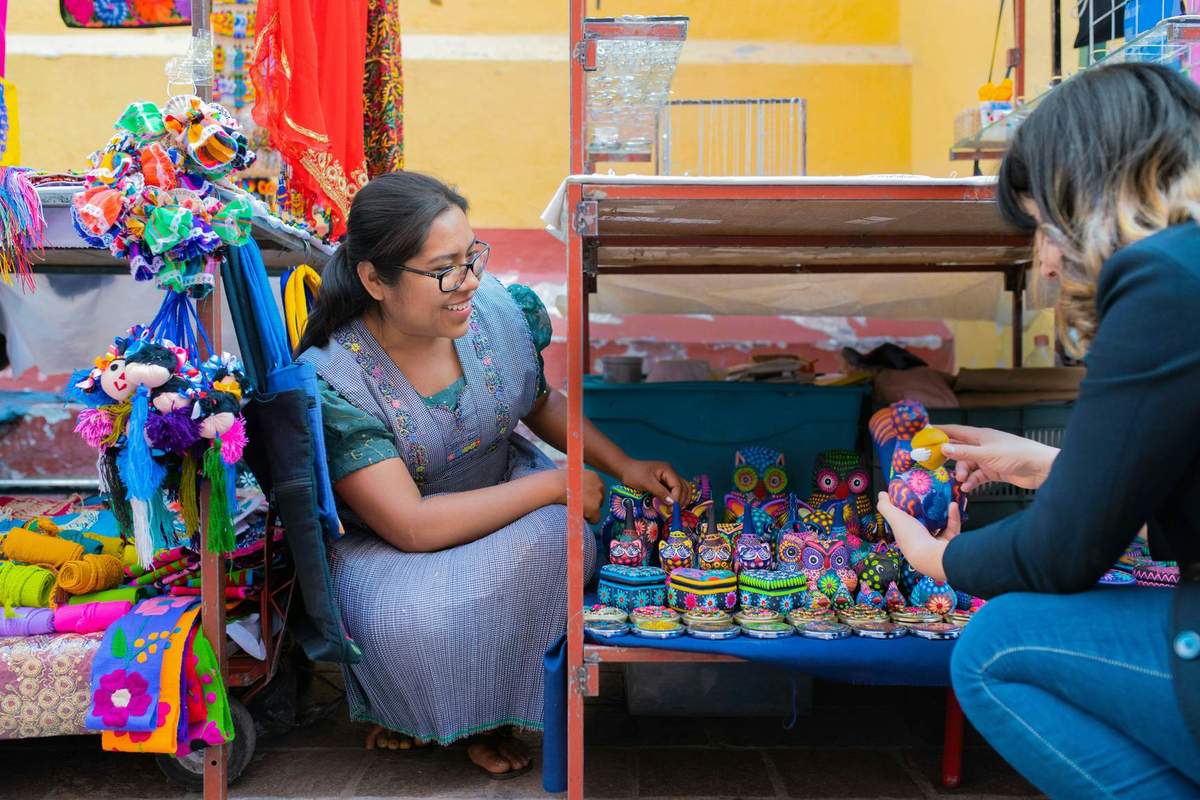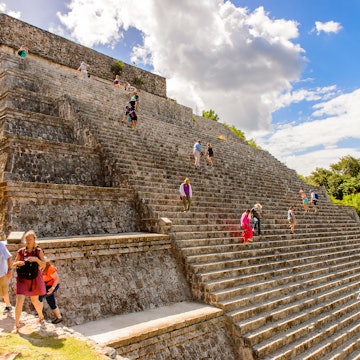

Explore beyond Cancún with these top day trips to Vallolid, underground water holes and more. Sun_Shine/Shutterstock
Since Cancún is one of Mexico’s crown jewels – a spectacular destination with stunning white-sand beaches and a nightlife that doesn’t stop – you might never want to leave. And we wouldn’t blame you.
Yet just beyond this bustling beach city, there’s a world of excursions and adventures around the Yucatán Peninsula that offer everything from a pleasant change of pace to a deeper understanding of the region’s cultural and natural richness, with ancient pyramids, otherworldly cenotes and colonial towns to explore.
Here are a few day trip options from Cancún – and all the practical info you need to make them happen.

1. Cenote-hop along the Riviera Maya
Travel time: around 1 hour by bus or car
The coastal road (Hwy 307) from Cancún to Tulum is dotted with spectacular cenotes, crystal-clear pools of water found in underground caves or in open-air jungle settings. You’ll never forget a day spent hopping between them, snorkeling and swimming until dark. Most are located just south of Playa del Carmen, though new ones open yearly.
Favorites include Cenote Azul, a luminous set of open-air cenotes with teal waters, stone walkways and overhangs for jumping into the water; Cenote Manatí, a rare oceanside cenote winding through a lush mangrove forest; and Dos Ojos, twin caverns decked out in stalagmites and connected by a chilly underground river. You can rent snorkel gear at each.
How to get to the cenotes along the Riviera Maya from Cancún:
Colectivos (shared minivans) are an inexpensive way to travel along Hwy 307; they leave every few minutes from outside Cancún’s bus station and stop at passengers’ request.
If they’re full, however, they won’t pick up passengers, so you may have to wait for an open seat between cenotes. Alternatively, rent a car for the day or hire a taxi to take you from spot to spot.

2. Take in the colonial vibe of Valladolid
Travel time: 2 hours by bus or car
Valladolid is a stupendously charming town just inland from Cancún. The central plaza is the heart of the action, a leafy affair surrounded by historic buildings (including the imposing Iglesia de San Servacio) and buzzing with locals. Late afternoons bring regional dance performances plus cart vendors selling elote (corn on the cob) and paletas (popsicles).
Consider visiting one of the town’s museums, including MUREM or Casa de los Venados with their respective (and impressive) collections of traditional dress and Mexican folk art. Or stroll down Calzada de los Frailes, a cobblestone street lined with artisanal boutiques and cozy cafes.
End with a tour of Templo de San Bernardino, an imposing Franciscan church and convent that doubled as a fortress during the 19th-century Caste War. If you have flexibility, stay overnight to soak in the town’s atmosphere, making time for a dip in one of the cenotes nearby.
How to get to Valladolid from Cancún:
ADO provides bus services from downtown Cancún to Valladolid several times per day. If you have a car, it’s a straight shot on Hwy 180 (libre) or Hwy 180D, the toll road (cuota).

3. Swim with sea turtles in Akumal
Travel time: 1 hour 20 minutes by bus or car
The calm, clear waters directly in front of the beachfront hamlet of Akumal are designated as a marine-conservation area. And with good reason: endangered loggerhead, hawksbill and green sea turtles feed, rest and nest here, and can be spotted in and around Akumal Bay year-round.
Come here for a snorkeling tour of the turtle feeding grounds, where they’re most frequently spotted (guides are required to enter the water and are easily hired on the beach). Or join staff members of Centro Ecológico Akumal for an evening walk to see nesting turtles and check on nests. Remember to give turtles plenty of space and never attempt to touch them.
Before you meet the charismatic creatures, spend some quality time on the gorgeous palm-laden beach, then head north to Half Moon Bay for an oceanfront meal at La Buena Vida.
How to get to Akumal from Cancún:
Colectivos from Cancún drop passengers off at the turn-off to Akumal, a dusty 1km (0.6-mile) walk to the beach. For more comfort, rent a car or hire a cab. There’s a parking lot and a taxi stand just outside the town arch.

4. Relax on Isla Mujeres
Travel time: 20 to 30 minutes by ferry
A quick ferry ride from Cancún transports you to Isla Mujeres, a laid-back island with backpacker roots. The main town is draped in murals and known for its superstar Playa Norte – a white-sand beauty with swaying palm trees and tranquil turquoise waters, all perfect for a relaxed beach day.
When not on the sand, you can take a stroll along Calle Hidalgo, a pleasant pedestrian street lined with artsy boutiques and eateries; in the evening, enjoy live music at a handful of open-air bars.
Alternatively, explore the island by golf cart, stopping at Playa Garrafón for snorkeling and at Punta Sur, with its crashing waves and Maya temple to Ixchel, the goddess of fertility. All are easily done in a day, especially with ferries running from 5:30am to midnight.
How to get to Isla Mujeres from Cancún
Ultramar operates two ferries from the Zona Hotelera at Playa Tortugas and Playa Caracol, and one just north of downtown Cancún at Puerto Juárez. Adult tickets are M$320 (US$16) each way.

5. Experience the Yucatán at Xcaret ecopark
Travel time: 1 hour by shuttle or car
Of the region’s many theme parks, Xcaret is the most ambitious: a sprawling, tropical playground on a beautiful oceanfront property, and a great place to get a taste of the Yucatan’s offerings. Spend your day floating in underground rivers, walking through butterfly gardens, snorkeling along reefs, and visiting folk art museums and Maya ruins.
There are live performances, too, including a spectacular nightly showstopper integrating Mexican folk dances, regional music and even a Maya ball game. For sure, it’s a packaged experience – there are even all-inclusive meal plans – but it makes for a stellar day trip, especially if you’re short on time.
How to get to Xcaret from Cancún:
Xcaret offers round-trip transportation from any Cancún hotel; it’s convenient, but you’re at the mercy of the shuttle schedule. There’s also ADO bus service several times daily from downtown Cancún. If you have a car rental, there’s free parking. Alternatively, taxi stands make cabbing it easy in either direction.

6. Wander through the Maya world at Chichén Itzá
Travel time: 2 hours 30 minutes by bus or car
West of Cancún sits one of the world’s most celebrated archaeological zones: Chichén Itzá, an iconic Maya ruin with magnificent palaces, pyramids and ball courts. The most recognizable monument at the site is El Castillo, a towering 25m-high (82ft-high) structure positioned to create the shadow of a serpent moving down its staircase at the spring and fall equinoxes.
Yet the ruins are a marvel at any time of year, as the sprawling complex reveals the complexities of ancient Maya life. Arrive early to avoid the midday heat and crush of tourists; consider hiring an onsite guide to gain a deeper understanding of the place and the people who built it. Afterward, cool off at the nearby Cenote Ik Kil or grab a bite in the tiny town of Pisté at Restaurante Las Mestizas, with a tasty Yucatecan menu.
How to get to Chichén Itzá from Cancún:
First-class buses travel from downtown Cancún to the ruins. If you rent a car, take the well-maintained toll road (Hwy 180D) for the fastest trip; to see villages along the way, take the libre (Hwy 180). A rail service on the Maya Train is in the works, too.
















